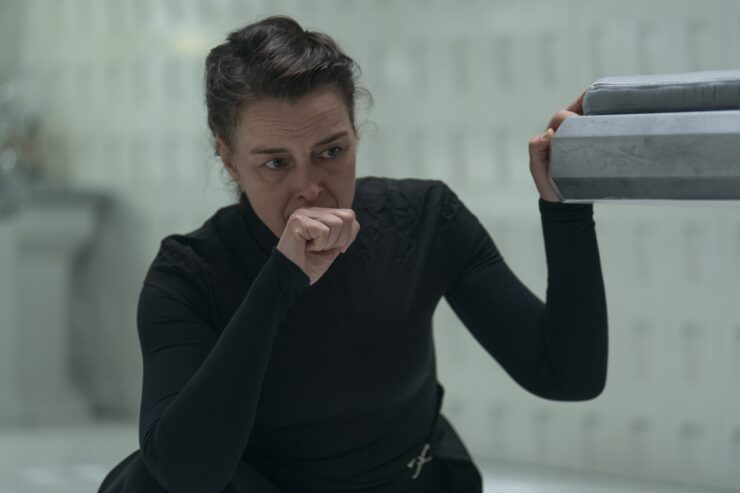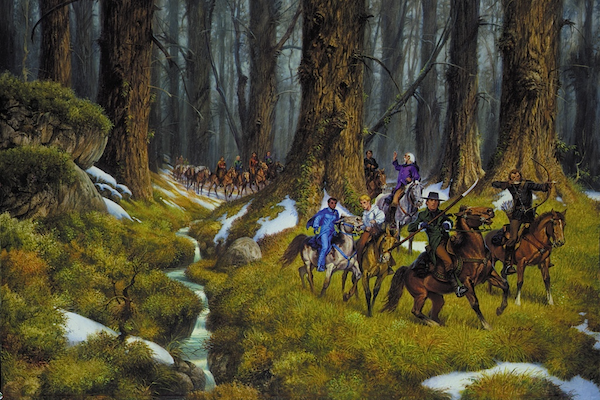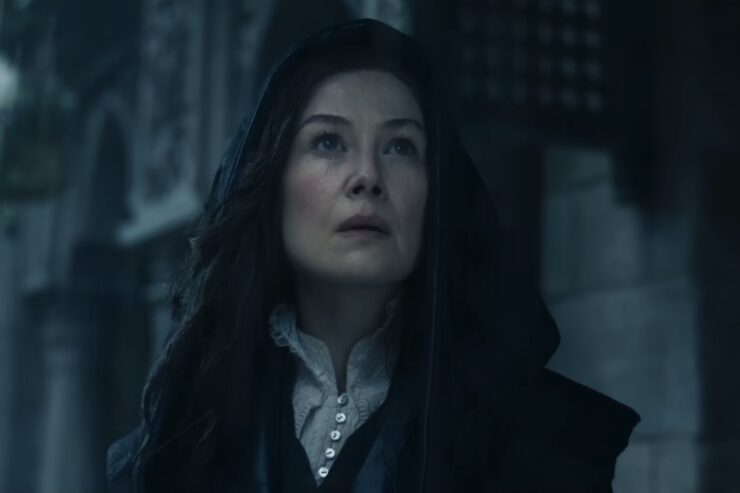Greetings, Tor.comlings! I come in peace, or at least in benign grumpiness, to bring you another Wheel of Time Reread Redux!
Today’s Redux post will cover Chapter 21 of The Shadow Rising, originally reread in this post, and Chapter 23, originally reread in this post.
All original posts are listed in The Wheel of Time Reread Index here, and all Redux posts will also be archived there as well. (The Wheel of Time Master Index, as always, is here, which has links to news, reviews, interviews, and all manner of information about the Wheel of Time in general on Tor.com.)
The Wheel of Time Reread is also available as an e-book series! Yay!
All Reread Redux posts will contain spoilers for the entire Wheel of Time series, so if you haven’t read, read at your own risk.
And now, the post!
Before we begin, a reminder that the format of the Reread Redux has changed: from now on I am only going to be commenting on chapters in which my reaction has changed significantly from before, based on the knowledge I had at the time.
Last time we stopped on Chapter 20, so we have not actually skipped anything yet. Yay!
Onward!
Chapter 21: Into the Heart
 Redux Commentary
Redux Commentary
[In this chapter, Rand makes unexpected travel plans and even more unexpected redecoration choices for the Stone, and Moiraine complains to herself about it.]
Possibly the thing I most enjoy about POVs from Moiraine and characters like her is how much they differ in what they see and pay attention to, as opposed to what I suspect I myself would see and pay attention to in their place. Meaning, I am always perhaps disproportionately fascinated by characters with the perspicacity to see the hidden political and social undercurrents in gatherings of people of power, precisely because I am fairly positive I would be the one who misses them entirely.
Not that I’ve ever had the occasion to hang out with large numbers of nobility in my life (nor even the modern-day American equivalent of such), but even without having tried it, I feel confident in my assessment that I simply do not have the temperament (or patience) to even detect that level of subtlety, much less be able to match it. I am many things, and “blunt” is definitely one of them. Hey, at least I embrace it.
I said in the original commentary that I found Moiraine opaque as a character even when we were in her head, but I was not talking about the nature of her character; I meant her ultimate goals and allegiances. This chapter contributed a great deal to the impression that Moiraine could not be a Darkfriend, but many fans continued to argue that she still could be one, even though she says right out in this chapter that she would not allow Rand to be turned to the Shadow. The argument being, you see, that there were quite a few Forsaken and high-level Darkfriends who in fact absolutely did not want Rand turned to the Shadow – because then he would be raised above them.
So the argument still holds, at this point. Later Moiraine POVs definitively disproved the “Moiraine is a Darkfriend” theory – most especially in New Spring, of course – but at this point it was still at least somewhat plausible. And indeed, Jordan did play the very trick later on that fans were suspecting of him here – just with Verin instead of Moiraine. Clever author.
But all that aside, we definitely do get a much clearer picture from this POV of what kind of person Moiraine was. Mainly, that she lived and breathed the subtleties of political maneuvering as easy as a fish breathes water – as is only right and proper for a woman who was born into the highest reaches of Cairheinin nobility and then became Aes Sedai. The apropos phrase “sink or swim” comes to mind. Aaand suddenly I have become Siuan Sanche with this analogy. Bad Leigh, no coffee.
“Into the heart he thrusts his sword,
into the heart, to hold their hearts.
Who draws it out shall follow after,
What hand can grasp that fearful blade?”
Once again, I never bothered to mention the Arthurian themes here in the original commentary (again, possibly because I thought they were pretty obvious)… and they still are really kinda obvious. However, I do have to congratulate Jordan on managing to make the mythological reference do double duty for him: as a reference, of course, but also as a neat solution to the problem of how to depower Rand after he acquired Phenomenal Cosmic Power via Callandor. Because if Rand had been able to walk around with Callandor the whole time, his ensuing battles would have been pretty undramatic. So obviously you have to figure out a way to get it away from him, but you also obviously can’t just leave it lying around either. Solution? The Sword in the Stone, only backwards. Noice.
In other news, I am amused at the complete tangent I went on in the original commentary about Star Wars and spaceships and whatever the hell. I mean, I stand by what I said there 100%, but wow did that stray from the subject.
Chapter 23: Beyond the Stone
![]() Redux Commentary
Redux Commentary
[Basically what we missed in Chapter 22 is how Rand and Co. left Tear, flipped a coin, and used the Portal Stone to take the extradimensional express to Rhuidean. In this one, we get the Rhuidean goers going, and embark everyone else on their first immersion course of Basic Aiel 101.]
I remarked in the original commentary that the infodumpiness of this chapter was mildly annoying for the first Reread, and it is even more so now. But again, I don’t really think that that is a fault of the chapter, so much as it is an indication of just how freakin’ well I know the ins and outs of this series by now.
Basically, I know all this shit, I know it very very well, and I don’t need to learn it no mo’. But that’s just me. And, er, probably most everyone else reading this, but anyway.
What is still relevant and/or still interesting about the infodumpiness of this chapter pertains to the comment I made in the original commentary about Jordan’s creation of Aiel society, and how it “skirts close to a whole host of issues surrounding cultural appropriation and portrayal of the Exotic Other and the million and one ways that can come back to haunt you that I just really don’t have the time to get into right now, though at some point I’m going to have to address it.”
And maybe I did address it later (I can’t remember if I did or not), but really I sort of addressed it quickly in that post: “For now, let’s just say that in my opinion Jordan did manage to dodge a lot of potential landmines by being so deliberately mix and match with his sources.” On reflection, this time around, I think I would actually strengthen that statement, and say that in my opinion Jordan’s portrayal of Aiel culture (and Sea Folk culture, and etc.) is not in fact cultural appropriation.
I know there are people who would disagree with me on that, and there’s no doubt many of those opinions have validity. Some possibly more than mine, as I am, after all, a member of a group (namely, white Americans) whose track record re: successfully recognizing cultural appropriation is… not stellar, shall we say. But with that caveat in mind, it seems to me that generally speaking, there are two factors which really divorce what Jordan did with the Aiel from what I understand to be “cultural appropriation”.
The first is simply a matter of practicality, in that to a certain extent, cultures are shaped by their environments, and thus even fantastical fictional cultures must take that into account if they want to ring true to their audiences. In other words, Jordan was not borrowing from societies like the early Israelites or the Zulu or the Native Americans to create the Aiel at random, or for reasons of “exoticness”; he was borrowing from peoples which all had in common certain key traits – i.e. being nomadic or semi-nomadic tribal societies, living in harsh or hostile environments where resources are scarce. Basically, for his society of desert-dwelling warriors to be even slightly realistic, Jordan really didn’t have many other options than to have his Aiel make many of the same cultural choices people in similar environments have historically made.
The second factor is a bit more esoteric, and probably more controversial as well, but nevertheless I feel like merely using aspects of a culture different than your own as inspiration for creating something new is not enough to make a claim of “cultural appropriation”. There also has to be, from what I can tell, a fundamental lack of respect shown for the integrity of the culture being borrowed from, and/or an attempt, unconscious or otherwise, to claim that cultural aspect for your own.
It’s a little hard to define the latter, but one way to put it would be to observe that the Aiel were not merely, say, Bedouins with the serial numbers filed off. They can be said to incorporate elements of Bedouin culture, along with many other traits from many other sources, but they are unmistakably their own thing, and that’s what makes the difference, in my opinion, between cultural appropriation and cultural inspiration.
As for the question of respect, obviously this is highly subjective, but I have never once gotten the impression that Jordan had anything other than the highest respect for every culture, nation, or society that he drew upon to create his fictional ones. Others may disagree, of course.
The other statement I made in the original commentary, correlating to this whole issue, is the seeming discrepancy of having a race of people with such pale coloring living in a desert for three thousand years, and yet not seeing any genetic shift towards more evolutionarily advantageous darker skin tones. I said that I myself did not know whether that was plausible from an anthropological standpoint or not, but several folks in the comments to the original post apparently did have that knowledge, and the general consensus seems to be that 3,000 years is simply not long enough, from an evolutionary point of view, for marked changes in that direction to occur.
Particularly not, as some pointed out, with the superior medical attention the Aiel were presumably afforded by the presence of channeling Wise Ones in their midst. If light-skinned Aiel were regularly being Healed of their melanoma and other sun-related maladies, enough that their chances of reproducing were not noticeably reduced, then there would have been no evolutionary pressure to select them out of the gene pool. In addition, several commenters observed that the apparent near-total lack of intermarriage with people outside the Aiel clans means that the genetic variation available was sharply limited in any case.
So that’s what all that is. What do you think?
And that’s the post for today, everyone! I hope the Americans in the audience had a lovely Labor Day, and I hope the non-Americans had a lovely late summer weekend, and I hope to see alla y’all back here in two weeks for the next post! Cheers!













